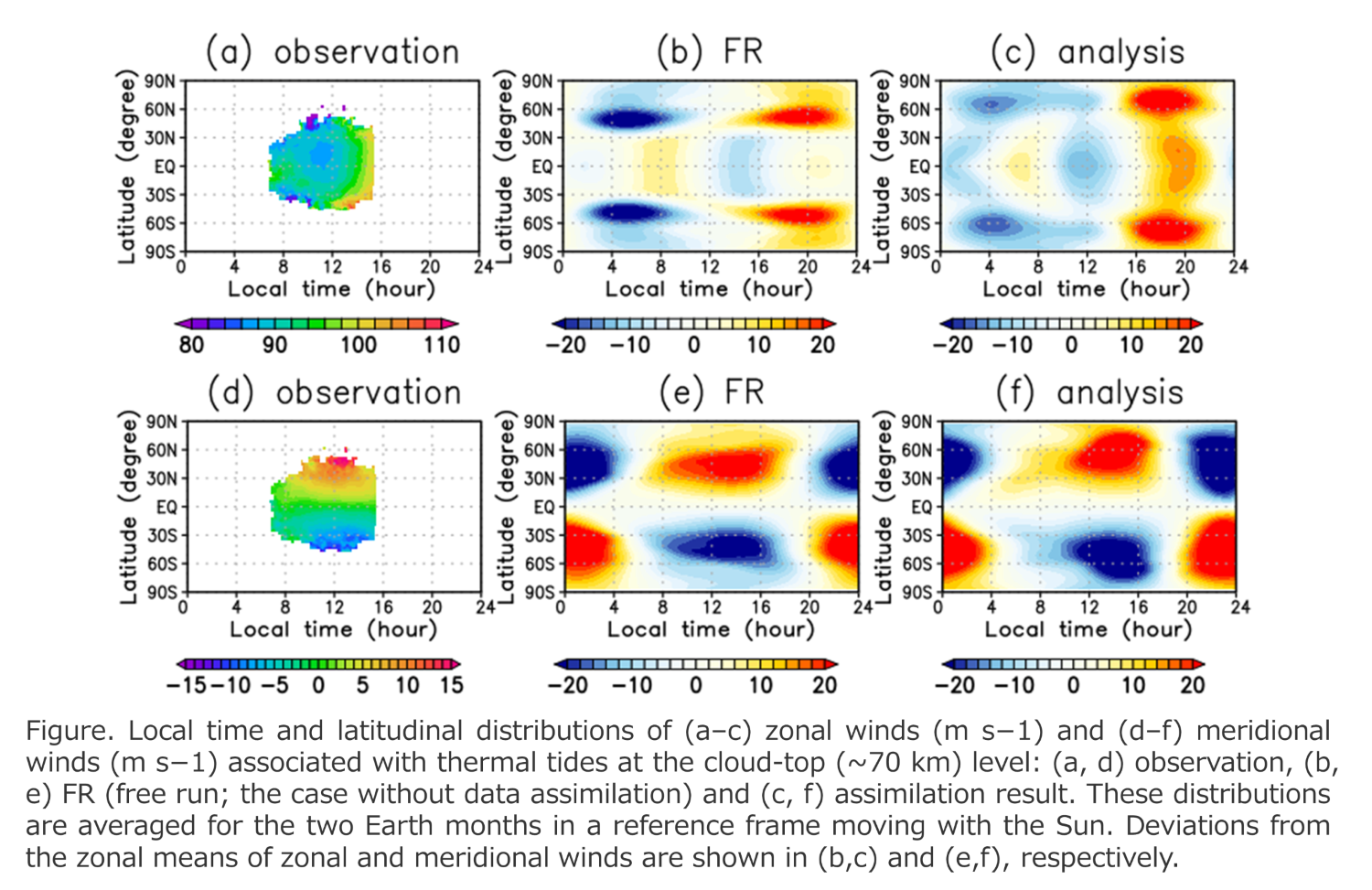Thermal tides reproduced in the assimilation results of horizontal winds obtained from Akatsuki UVI observations
- 1Research and Education Center for Natural Sciences, Keio University, Yokohama, Japan (yukiko@gfd-dennou.org)
- 2Institute of Space and Astronautical Science, Japan Aerospace Exploration Agency, Sagamihara, Japan
- 3Department of Physics, Keio University, Yokohama, Japan
- 4Department of Astrophysics and Atmospheric Science, Kyoto Sangyo University, Kyoto, Japan
- 5Graduate School of Frontier Sciences, The University of Tokyo, Kashiwa, Japan
- 6Faculty of Environmental Earth Science, Hokkaido University, Sapporo, Japan
- 7Department of Earth Sciences, Okayama University, Okayama, Japan
- 8Department of Cosmosciences, Hokkaido University, Sapporo, Japan
- 9Disaster Prevention Research Institute, Kyoto University, Uji, Japan
- 10Research Center for Computer Science (R-CCS), RIKEN, Kobe, Japan
- 11Application Laboratory, Japan Agency for Marine-Earth Science and Technology, Yokohama, Japan
- 12Center for Planetary Science, Kobe University, Kobe, Japan
- 13Department of Planetology, Kobe University, Kobe, Japan
Observations of the Venus Climate Orbiter “Akatsuki” provide us with horizontal distributions of the horizontal winds derived from cloud tracking of the Ultraviolet Imager (UVI) and of temperature observed by the Longwave Infrared Camera (LIR). However, these observations are limited in altitude, local time (day or night side), and frequency. Then it is difficult to elucidate the general circulation of the Venus atmosphere, including various temporal and spatial scales, only from observations. In this study, we produced a Venus dataset (analysis) that has high temporal and spatial resolutions by assimilating horizontal winds derived by the Akatsuki observations. At the top of the cloud layer of Venus, there are planetary-scale atmospheric waves that are excited by the solar heating and move with the sun, called the thermal tides. In this presentation, we focused on thermal tides to verify the analysis.
We use the Venus atmospheric data assimilation system “ALEDAS-V" (Sugimoto et al., 2017) [1] for assimilation and the Venus atmospheric general circulation model “AFES-Venus" (Sugimoto et al., 2014) [2] for ensemble forecasts. AFES-Venus is a full nonlinear dynamical GCM on the assumption of hydrostatic balance, designed for the Venus atmosphere. ALEDAS-V uses the Local Ensemble Transform Kalman Filter, and is the first data assimilation system for the Venus atmosphere. We assimilated the cloud top (~70km) zonal and meridional winds obtained by tracking morphology, using Akatsuki UVI data (Horinouchi et al., 2021) [3] from September 1st to December 31st, 2018. The assimilation data (analysis) from October 1st to November 30th, 2018, is analyzed, because the root-mean-square-deviations (RMSD) from FR (free run; the case without data assimilation) are stable.
Figures (a) and (d) show the observed zonal and meridional winds, respectively. The zonal wind has a local minimum near 11 LT (local time) around the equator (Figure a). The meridional wind is the weakest at the equator and increases with latitude, and the amplitude is maximum around noon (Figure d) in the local time direction. Note that these winds obtained from observations exist only the dayside equatorward of 50° latitudes (Figure a and d).
Figures (b) and (e) show the deviations from the zonal means of zonal and meridional winds at an altitude of 70 km in the FR, respectively. For zonal wind, diurnal (zonal wavenumber 1) and semidiurnal (zonal wavenumber 2) tides are dominant at latitudes poleward and equatorward of 30, respectively (Figure b). The zonal wind deviation has a local minimum at 14-15LT, which is ~ 2 hours behind the observation (Figures a and b). The meridional wind deviation is polar and equatorial on the dayside and nightside, respectively (Figure e), and this distribution is consistent with Akatsuki's observation (Figure d).
Figures (c) and (f) show the zonal and meridional winds as a result of assimilation, respectively. The zonal wind in the equatorial region have a local minimum near 11 LT. The assimilation improved the semidiurnal tide closer to the observations (Figures a and c). The meridional wind is not so different from FR. This is probably because FR was originally very similar to observations (Figures d and f). These results are consistent with a previous study by Sugimoto et al. (2019) [4]. In addition, while the observed winds exist only on the dayside, the results of assimilation show that the horizontal winds field is modified significantly even on the nightside. It is suggested that spatially limited data assimilation can improve the general circulation of GCM.
In the future work, we are planning to release the assimilation dataset as the “objective analysis data” of Venus for the first time in the world.

[1] Sugimoto, N., et al. Development of an ensemble Kalman filter data assimilation system for the Venusian atmosphere. Scientific Reports 7(1), 9321 (2017).
[2] Sugimoto, N., et al. Baroclinic instability in the Venus atmosphere simulated by GCM. J. Geophys. Res. Planets 119, 1950–1968 (2014).
[3] Horinouchi, T., et al. Venus Climate Orbiter Akatsuki Cloud Motion Vector Data Set v1.0, JAXA Data Archives and Transmission System (2021).
[4] Sugimoto, N., et al. Impact of data assimilation on thermal tides in the case of Venus Express wind observation. Geophys. Res. Lett. 46, 4573–4580 (2019).
How to cite: Fujisawa, Y., Murakami, S., Sugimoto, N., Takagi, M., Imamura, T., Horinouchi, T., Hashimoto, G. L., Ishiwatari, M., Enomoto, T., Miyoshi, T., Kashimura, H., and Hayashi, Y.-Y.: Thermal tides reproduced in the assimilation results of horizontal winds obtained from Akatsuki UVI observations, Europlanet Science Congress 2022, Granada, Spain, 18–23 Sep 2022, EPSC2022-309, https://doi.org/10.5194/epsc2022-309, 2022.

